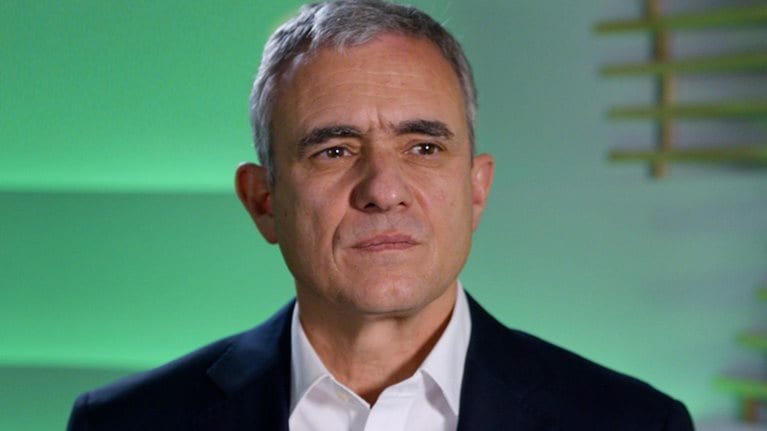In this edition of Author Talks, McKinsey Global Publishing’s Rick Tetzeli chats with McKinsey senior partners Eric Lamarre, Kate Smaje, and Rodney Zemmel about their new book, Rewired: The McKinsey Guide to Outcompeting in the Age of Digital and AI (Wiley, June 20, 2023). The authors discuss how companies can build and flex their rewiring muscle by leveraging the power of AI, enhancing customer experience, and driving profitability through an ever-evolving process of transformation. An edited version of the conversation follows.
Why did you write this book?
Kate Smaje: I think in many ways we chose to write this book from a point of frustration—frustration that our clients are struggling with what it really takes to make a digital transformation work. It’s very easy in some ways to paint a digital lick of paint over everything you do and come up with the “whats.”
But the “how” of it is incredibly hard. So this was our way of being able to open source the learnings that we’ve had over the past five, six years, across hundreds of digital transformations, to really open that up to our clients and say, “Here’s how we think we do it right.”
Eric Lamarre: The book has a bit of history because it didn’t start as a book. By 2017, we were three or four years into a number of digital transformations. We’re stepping back, as a team, and we’re saying, “Is there a pattern here? Is there a recipe to the successful ones?”
We take the first 30 to 35 transformations that were mature enough at the time. We back-engineer to ask, “What seems to be emerging as the recipe behind the successful ones?” That internally at McKinsey was called the playbook: playbook version 1.0, 2017.
Then every 18 months, 24 months, we would renew the playbook, essentially take stock of all the new experiences of all our different clients and ask to what extent does the recipe change? Is it fine-tuned? Does it converge? That became 2.0, 3.0. What we released just before the holidays was 4.0.
Rodney Zemmel: We really think it’s “show me the money” time in digital. The amount of money that has been spent, and frankly wasted, in digital and technology by many leading, extremely capable organizations and teams over the years is large and growing. As Eric described in the research, we believe there is a right way, a better way, to do it. We wanted to share that.
How does AI change a company’s digital transformation?
Rodney Zemmel: AI is the thing everyone is talking about right now—or, more specifically, generative AI—so large language models are the thing that everyone is talking about. They’re amazing. They pass the Arthur C. Clarke test of technology that’s indistinguishable from magic.
Think about it as a business enterprise, not as a consumer writing fabulous birthday poems, but how you’re going to get value from it. That’s actually a bit of a risk that put us back in the digital of 2018, where there’s going to be pilot proliferation across the company, and everybody’s trying things, and so on.
For a complicated enterprise, a company, or a big organization to get value from digital transformations, we actually think you need to start from a real view of where the value is and a road map around how you’re going to capture that value for your business. You need to think through a whole technology architecture that isn’t just the model.
There’s actually going to be quite a few, or at least a handful of, different large language models out there. What you’re going to need is to have your data in the cloud, to have your data structured or at least indexed properly, to have what we call MLOps [machine learning operations], or in this case it’ll be LMOps [learning model operations], to make sure the models are safe and scalable across the enterprise.
You need your teams to work in a way that takes advantage of it. You need to measure it and adopt and scale it. Guess what? Those are all the things that we think you need to be successful in a digital transformation.
Eric Lamarre: Just yesterday we were with the CEO of a very large bank here in New York. He was discussing how AI is really changing the performance of that bank, with 300 or 400 models being operated. For us, AI is that path to faster return on your tech investments.
Kate Smaje: When we had the debate about, “Should we talk about AI? Should we talk about digital?” one of the other things we spent a lot of time talking about in technology was also this notion of AI triggers or prompts. It’s the notion of not just machine intelligence but also human intelligence alongside it.
What I like about one of the upgrades on version 4 of our playbook is how we’ve thought about how talent gets unlocked through this. I think in previous digital transformations, it has been easy to focus on the digital part. But with AI, it naturally triggers you to say, “Hang on a minute. I’ve got to think about where the human is in the loop of this in a much more fundamental way.” That’s different.
In previous digital transformations, it has been easy to focus on the digital part. But with AI, it naturally triggers you to say, ‘Hang on a minute. I’ve got to think about where the human is in the loop of this in a much more fundamental way.’
What motivated you to create a how-to manual?
Eric Lamarre: We’re avid readers. We read all the books out there. Before we started on this journey, and this was a challenge, we thought that we were just going to write another book about digital transformation and put it on the shelf with the other 50 books we have on the subject.
We read them all. Many of them are good. But they treat the topic partially. They’ll focus on strategy, or they’ll focus on a specific aspect within an industry. They tend to actually not go very far in terms of the how-to, the implementation.
They’ll tell you, “Talent is important.” But then how do I specifically recruit a data engineer? What are the steps? What are the tests that I should be giving that data engineer? That level of practicality was missing. We tried to attack the problem with something that would be holistic, cover all the right angles, and be specific enough that you could actually say after having read it, “That’s what I’m going to do Monday morning,” then integrate it.
Integration, which is what happens in chapter one, is aligned with what happens in chapter 25 and with what happens in chapter 35. That integration across one language, one common thought, is actually fairly important when you are in charge of architecting the transformation or rewiring of a company.
Kate Smaje: I think as well, because our teams tell us that the “how” is hard, what we’ve really done here is to take the playbook that our teams—hundreds of teams every single week—are using across McKinsey when they’re helping our clients to figure this out and really just opened that up to everybody else.
So it’s not the theory. It’s the practicality of what it really takes to move the needle. What does it really take to be a leader, and not a laggard, in this space? How do you make sure you’re not one of the vast majority that stalls in their transformation in some way, shape, or form? Or if you have stalled, what’s the unlock, what’s the pivot that’s going to get you out of that?
Rodney Zemmel: When we were thinking, “Should we do this?” we actually referred to another McKinsey book.
There’s a book called Valuation by one of our colleagues, Tim Koller, that is really the textbook on how to value a company. You might read it once when you’re a junior consultant or a banker or a CFO. But it’s on your shelf, and it’s a reference guide.
When you’re working on a hard valuation problem, you go to it. You say, “Here’s how you do it.” That’s what we want this book to be. Hopefully you’ll pull it down from the shelf often. It lays out the method. But we know that actually there is a real learning curve to applying the method. So we’re also hoping that by publishing the book, we’re not making ourselves obsolete. But I guess we’ll see.
Why is digital and AI transformation a career-long commitment?
Kate Smaje: We’ve talked about this a lot between the three of us. One of the things that actually annoys me about the term digital transformation is it has this connotation that at some point, I am done.
I tick the box. We all pat each other on the back. And off we go to whatever is next. I don’t think you’re ever done with digital transformation. For me, it’s to try and get across this notion that this is a journey; it’s a muscle that you’re constantly building, you’re constantly honing, to get better.
We want to set that as a mindset almost at the start of the book so that folks think that this is not, “OK, I go through every part of this book, and I am done.” It’s more, “I’m going to go through every part of this book. I’m going to learn how I’m going to keep evolving as a company over time.” I think when you look at some of the best transformers out there, they are transforming. They’re never done.
Eric Lamarre: The learning journey at the beginning is fundamental. That’s probably at least my golden rule. You don’t start anything other than take your top team and go and learn for three, four, five months. What does that mean, go and learn?
Go visit other companies that have done this, that are further down their journey. Now read the book together. Start to create a common language from this book or whatever method you want to use, but creation of a common language. What’s a data engineer? What’s a technology stack? What do you mean by data architecture?
What does it mean when you say track the value? How do we do that for digital solutions? Start to create a common language so that all the team players play the same sport. Then know where to focus the effort, because often what we’ve found in the first generations of these, and that was one of our first lessons in playbook version 1.0, is people were implementing use cases.
One use case never does the job. It is a family of many that needs to be strong together to actually create meaningful impact and change experiences. So back to: What are you doing the first three, four, five months? You learn by visiting others. You create a common language. You decide where you’re going to focus the effort for maximum impact.
One use case never does the job. It is a family of many that needs to be strong together to actually create meaningful impact and change experiences.
Rodney Zemmel: Eighty-nine percent of companies are already doing something that they call a digital transformation. By the way, I don’t even know who the 11 percent are. I guess they don’t talk to us.
But that’s not the hard part. People get the joke. The hard part is that they need to actually be rewired—rewired for digital and AI. The difference between the companies that’ve tasked CIOs [chief information officers], or rebranded CIOs as CDIOs [chief digital information officers], and then tasked them with driving this, versus the companies that are really rewiring, is huge.
When we talk about companies doing this for the people, doing this for the rest of their life span, this is the future of business and the future of society. It’s the world going from you having a CIO on your team—and this is the task of the CIO, maybe joined up with a business leader—to technology is fully embedded in business.
Business leaders need to be technology leaders.
How do you know if business is ready to be digital not just do digital?
Rodney Zemmel: One of the other things from our survey last year is we looked at just how many members of a C-suite, of the CEO’s direct reports, are tech savvy. When I first saw the data on tech savviness and the likelihood of the success of a digital transformation, I thought the team was giving us the dummy chart with the data not filled in yet.
But it was the real data. It’s an incredible correlation: if you’ve got three, five, or seven members of your C-suite who are tech savvy, your chances of succeeding, of ending up in the top quartile of economic performance, are just much higher than if you’ve got one or two tech-savvy members of your team. It’s business. That’s why it’s going to be the journey that continues.
Kate Smaje: That’s actually one of my favorite kind of checks early on in a digital transformation. You’re with a leadership team. You ask a very innocuous question like, “Oh, how’s this digital thing?” You ask about an initiative or proof of concept, or whatever, that they’re doing: “How’s that going?”
You watch. If everybody in the room turns around and looks at the chief digital officer or chief data officer or CIO, you know something is fundamentally wrong. They haven’t rewired, because what should actually happen is anyone in that room should be ready to say something like, “Actually, here’s how I think it’s really affecting my P&L in this part of the business.”
Rodney Zemmel: I was at a conference on the West Coast late last year. We were having a discussion on doing digital versus being digital. We were having a discussion around: What is a digital culture? It was one of those fluffy discussions, as culture discussions can often become.
I was challenged to say, “Give me one sentence that tells the difference between a digital culture and an old IT culture.” After some back and forth, we actually got it down to one word. It’s a little bit like your you-know-who looks at whom in the room test.
That one word was “requirements.” If you’ve got a company where the IT team or any of the business teams are running around talking about requirements—“we need a requirements document; we’re gathering requirements; we’re setting requirements; did the project meet its requirements?”—that’s an old IT culture.
You are managing projects. You’re getting input for those projects. You’re delivering. It’s vendorized. Instead, you need a business leader and a technology leader together. Or maybe that becomes one person, a business leader who’s tech savvy, or a tech leader who’s business savvy. Those people together need to own a problem and a solution to a problem on an ongoing basis. They need to own a digital product or an AI product, rather than go back and forth about requirements documents with each other.
What is the most important part of a digital and AI transformation?
Rodney Zemmel: We’ve all seen successes; we’ve all seen failures. If you’re not focused on where the money is and how you’re going to reimagine the business to really create value, rather than just take a bunch of processes and do them better or launch some little thing, the rest doesn’t matter. You can have the best people in the world on your technology teams, and you can have the best technologists in your business teams. But if you’re not really lasered in on, “Here’s how we’re going to, as a business, make more money by doing new things,” then the rest doesn’t matter. But you need both. So I would say necessary, but not sufficient.
You can have the best people in the world on your technology teams, and you can have the best technologists in your business teams. But if you’re not really lasered in on, ‘Here’s how we’re going to, as a business, make more money by doing new things,’ then the rest doesn’t matter.
Kate Smaje: I’m going to try and trump you both in that even if you know where the value is, and even if you have that top team alignment around it, none of that matters unless you actually have a way of delivering it. For me, the miss often is that everybody spends so much time on the what: “What is it we’re going to do, and have I got the best technology in place to be able to do it?”
They miss the fact that somebody ultimately has to use that technology. Ultimately, somebody’s job or function or whatever needs to change as a result of that technology. I like the wrapper that you put around it, because otherwise, it stops—stops short.
Eric Lamarre: Those are two very good answers.
Kate Smaje: But …
Eric Lamarre: But a decade ago, I worked with a bank for three years on the start of their digital transformation. I helped them, along with other McKinsey colleagues, on many, many fronts—many fronts that would be covered by the book today and others.
When I look back on what the most important piece of work I have done with that team is, it was the initial trip to Silicon Valley with the CEO and the C-suite, spending two or three days visiting companies, learning a new language, and aligning on the art of the possible.
We’re a bank; we will be able to develop software like this. It’s not rocket science. You can build the confidence. That first trip was so successful. One month later, they were making a second one. A few months after that, the board was on the plane to do the same trip.
When I look back on what I did with that company, I feel that moment was a crystallizing moment where ambitions went up, confidence went up. Alignment on what we needed to do to be more like a tech company and embed that technology mindset inside our bank was important.
Watch the full interview



